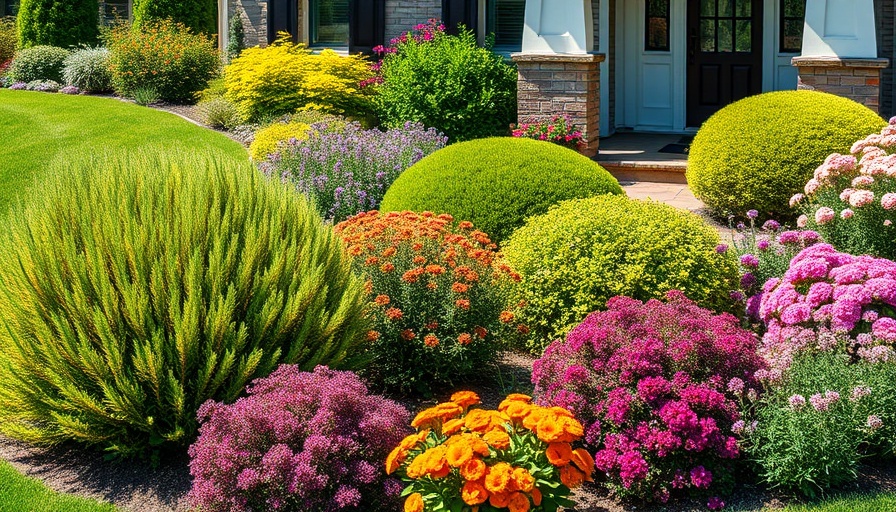
Unlocking Curb Appeal: The Power of Shrubs in Landscaping
Your home's exterior is a reflection of your style, and the first impressions made on visitors begin with the landscapes. Investing in shrubs for your front garden not only enhances beauty and structure but also offers benefits like improved privacy and a vibrant visual palette throughout the seasons. This article explores 17 remarkable shrubs that can elevate curb appeal, proving that beautiful landscapes start at the front door.
1. Boxwood: The Classic Evergreen
Boxwood (Buxus) remains a favorite due to its dense evergreen foliage and versatility in landscaping. It can be shaped into stunning hedges, globes, or decorative shapes, making it a staple for formal gardens.
Height: 2-6 feet
Best for: Formal landscapes, year-round greenery
2. Hydrangea: A Burst of Summer Color
Known for their large, vibrant blooms, hydrangeas (Hydrangea macrophylla) add joyful splashes of pink, blue, and white to gardens depending on soil pH. They can create a welcoming atmosphere and fit seamlessly into any cottage-style aesthetic.
Height: 3-6 feet
Best for: Summer blooms, color variety
3. Lilac: Fragrant Beauty
Crowning the garden with delightful, lavender-purple blossoms, lilacs (Syringa vulgaris) are celebrated for their nostalgic scent and spring blooms. Position them near your entryway for a fragrant greeting.
Height: 6-12 feet
Best for: Fragrant flowers, spring blooms
4. Azalea: Colorful and Low-Maintenance
With hues spanning pink, red, and purple, azaleas (Rhododendron spp.) flourish in partial shade and require minimal upkeep, making them a splendid choice for homeowners looking for vibrant spring color that complements their foundations.
Height: 2-5 feet
Best for: Spring color, partial shade gardens
5. Butterfly Bush: Nature's Pollinator Magnet
Known scientifically as Buddleia, the Butterfly Bush is a beacon for butterflies and bees, featuring tall flower spikes in shades of purple, pink, and white from summer to fall. This shrub does not just beautify your garden; it supports vital pollinator populations.
Height: 5-7 feet
Best for: Pollinator gardens, long-lasting blooms
6. Dwarf Alberta Spruce: Compact and Charming
The Dwarf Alberta Spruce (Picea glauca ‘Conica’) presents attractive evergreen features with its neat conical shape. It's ideal for small spaces, adding vertical interest without overwhelming the landscape.
Height: 4-6 feet
Best for: Year-round interest, compact spaces
7. Spirea: A Low-Maintenance Option
Spirea (Spiraea spp.) showcases a variety of colors and long-lasting blooms, making it an excellent choice for those seeking a simple yet colorful addition to enhance their garden’s texture.
Height: 2-4 feet
Best for: Low-maintenance, colorful flowers
8. Yew: The Hardy Evergreen
Yew shrubs (Taxus spp.) offer durability and can be formed into various shapes or allowed to grow naturally. Their dark green foliage not only provides structure but also maintains privacy throughout the year.
Height: 4-8 feet
Best for: Year-round privacy, formal hedging
9. Future Trends in Shrub Gardening
As homeowners increasingly seek low-maintenance and sustainable landscaping options, the trend toward utilizing native shrubs and integrating technology into garden planning is rising. Using apps for garden design and maintenance can help homeowners make informed decisions about shrub placement and care, enhancing curb appeal effortlessly.
10. Making the Right Decisions for Your Landscape
Plant selection should align not only with aesthetic goals but also environmental considerations. Understanding local climate and soil conditions can dictate the success of your landscaping efforts with shrubs. Choosing the right plantas can create a resilient, beautiful landscape that thrives for years to come.
Enhancing your home’s curb appeal doesn't have to be daunting. As you explore these shrubs, consider how they can transform your space and make a lasting impression on your visitors. Think about your landscaping goals and how these options can be tailored to meet your unique needs.
 Add Row
Add Row  Add
Add 




 Add Row
Add Row  Add
Add 

Write A Comment